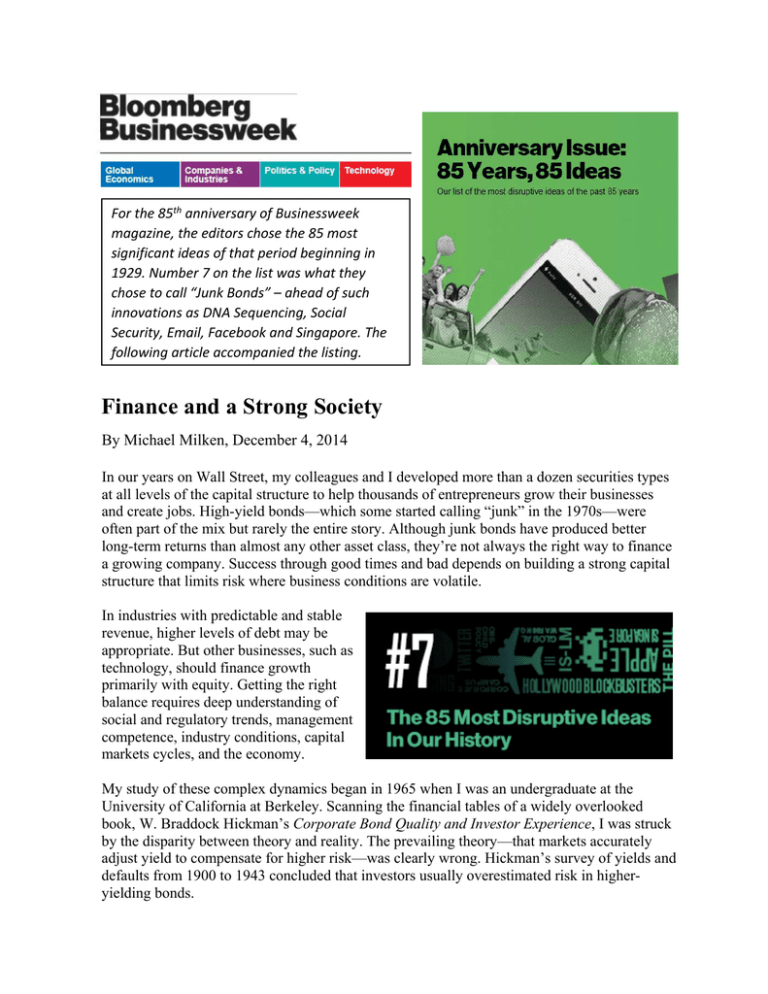Document 12899974
advertisement

For the 85th anniversary of Businessweek magazine, the editors chose the 85 most significant ideas of that period beginning in 1929. Number 7 on the list was what they chose to call “Junk Bonds” – ahead of such innovations as DNA Sequencing, Social Security, Email, Facebook and Singapore. The following article accompanied the listing. Finance and a Strong Society By Michael Milken, December 4, 2014 In our years on Wall Street, my colleagues and I developed more than a dozen securities types at all levels of the capital structure to help thousands of entrepreneurs grow their businesses and create jobs. High-yield bonds—which some started calling “junk” in the 1970s—were often part of the mix but rarely the entire story. Although junk bonds have produced better long-term returns than almost any other asset class, they’re not always the right way to finance a growing company. Success through good times and bad depends on building a strong capital structure that limits risk where business conditions are volatile. In industries with predictable and stable revenue, higher levels of debt may be appropriate. But other businesses, such as technology, should finance growth primarily with equity. Getting the right balance requires deep understanding of social and regulatory trends, management competence, industry conditions, capital markets cycles, and the economy. My study of these complex dynamics began in 1965 when I was an undergraduate at the University of California at Berkeley. Scanning the financial tables of a widely overlooked book, W. Braddock Hickman’s Corporate Bond Quality and Investor Experience, I was struck by the disparity between theory and reality. The prevailing theory—that markets accurately adjust yield to compensate for higher risk—was clearly wrong. Hickman’s survey of yields and defaults from 1900 to 1943 concluded that investors usually overestimated risk in higheryielding bonds. After studying capital structure at Wharton, I joined Wall Street’s leading research firm in 1969. At the time, most analysis focused solely on the past, primarily book value and reported earnings. But my experience showed that through rigorous research and a sharper focus on future cash flow, we could price and reward investment risk more precisely. The proof came in 1974, when companies with the right capital structure prevailed despite a doubling of interest rates, a stock market crash, and a severe recession. Effective use of high-yield bonds had been an important economic vehicle even before Alexander Hamilton used them to finance America’s Revolutionary War debt. In the 19th century, European investors bought the junk bonds that built America’s railroads and other major industries. By the 20th century, three types of capital—human, social, and financial—had become closely intertwined. Without social capital—universal education, for example—human capital can’t develop. Without human capital—skilled people—financial capital can’t be deployed productively. These relationships can be stated in an equation that I first developed half a century ago: P = Ft (HC+SC+RA). Prosperity equals the effect of financial technology acting to multiply the value of human capital, social capital, and real assets. “Financial technology” includes innovative processes and components such as convertible bonds, preferred stock, high-yield bonds, collateralized loans, equity-linked instruments, securitized obligations, and derivatives. “Human capital” is the collective talent, training, and experience of people. “Social capital” includes, among other concepts, the rule of law, property rights, education, public health, and transparent markets. “Real assets” are tangible items on the balance sheet. This “prosperity formula” has stood the test of time. Stable economic growth most often occurs where people have access to education and health care, can participate freely in the political process, and can aspire to property ownership. The formula remains my core understanding of the relationship between finance and a strong society. As late as the 1960s, access to financial capital was controlled by relatively few bankers who dispensed it to privileged clients—a few hundred corporations with an investment-grade rating. Such companies, whose managements were almost all male, white, and part of the Establishment, were considered safe. This institutionalized the denial of capital to many entrepreneurs with great business ideas. Among its victims were minorities and women. Financial technology, including the prudent use of non-investment-grade debt and many other securities types, helped right that wrong. In the 1970s public and private markets started to replace banks and insurance companies as the main capital source. The results were revolutionary: From 1970 to 2000, these “junk” companies created 62 million net new jobs in America even as the large “investment-grade” businesses contracted by 4 million employees. The growing flexibility of the capital markets allowed many companies to recapitalize during the most recent economic downturn, proving once again that capital structure matters.





